A Study on Thermal Management Systems for Fuel-Cell Powered Regional Aircraft
Abstract
1. Introduction
2. Literature Review
2.1. Hydrogen Production
2.2. Economic and Storage Challenges
2.3. Fuel Cell Propulsion
2.4. Fuel Cell Cooling
2.5. Heat Transfer Technologies
3. Implementation
3.1. Reference Aircraft and Propulsion System
3.2. Mission Profile
3.3. Components
3.3.1. PEMFC
3.3.2. Tank
3.4. Architectures
3.5. Validation and Verification
3.6. Emissions
4. Results and Discussion
4.1. Propulsion Model
4.2. PEMFC
4.3. Tank
4.4. Cycle 2
4.5. Cycle 1
4.6. Overall Analysis
5. Concluding Remarks
Author Contributions
Funding
Data Availability Statement
Conflicts of Interest
Abbreviations
| BoP | Balance-of-Plant |
| EGW | Ethylene Glycol-Water |
| EM | Electric Motor |
| FC | Fuel Cell |
| FCHX | Fuel Cell Heat Exchanger |
| FHX | Fuel Heat Exchanger |
| GH2 | Gaseous Hydrogen |
| GHG | Greenhouse Gases |
| HEX | Heat Exchanger |
| HHV | High Heating Value |
| LCA | Life Cycle Assessment |
| LH2 | Liquid Hydrogen |
| PEMFC | Proton-Exchange Membrane Fuel Cell |
| RA | Ram Air |
| RHX | Ram Air Heat Exchanger |
| SHX | Skin Heat Exchanger |
| SOFC | Solid-Oxide Fuel Cell |
| TMS | Thermal Management System |
| TLAR | Top Level Aircraft Requirements |
| VCS | Vapor Compression System |
References
- European Commission. The European Climate Law. 2020. Available online: https://ec.europa.eu/commission/presscorner/api/files/attachment/862887/european-climate-law-march-2020_en.pdf (accessed on 9 February 2025).
- European Commission. European Green Deal: The Commission Proposes Transformation of EU Economy and Society to Meet Climate Ambitions. 14 July 2021. Online. Available online: https://ec.europa.eu/commission/presscorner/detail/en/IP_21_3541. (accessed on 9 February 2025).
- IEA. Tracking Clean Energy Progress. 2023. Available online: https://www.iea.org/reports/tracking-clean-energy-progress-2023 (accessed on 9 February 2025).
- Fuel Cells and Hydrogen 2 Joint Undertaking. Hydrogen-Powered Aviation—A Fact-Based Study of Hydrogen Technology, Economics, and Climate Impact by 2050; Publications Office of European Union: Luxembourg, 2020. [Google Scholar] [CrossRef]
- Adler, E.J.; Martins, J.R. Reprint of: Energy demand comparison for carbon-neutral flight. Prog. Aerosp. Sci. 2025, 153, 101084. [Google Scholar] [CrossRef]
- Abu Salem, K.; Palaia, G.; Quarta, A.A. Review of hybrid-electric aircraft technologies and designs: Critical analysis and novel solutions. Prog. Aerosp. Sci. 2023, 141, 100924. [Google Scholar] [CrossRef]
- Adler, E.J.; Martins, J.R.R.A. Blended Wing Body Configuration for Hydrogen-Powered Aviation. J. Aircr. 2024, 61, 887–901. [Google Scholar] [CrossRef]
- Suwaileh, W.; Bicer, Y.; Al Hail, S.; Farooq, S.; Mohamad Yunus, R.; Rosman, N.N.; Karajagi, I. Exploring hydrogen fuel as a sustainable solution for zero-emission aviation: Production, storage, and engine adaptation challenges. Int. J. Hydrogen Energy 2025, 121, 304–325. [Google Scholar] [CrossRef]
- Adler, E.J.; Martins, J. Hydrogen-powered aircraft: Fundamental concepts, key technologies, and environmental impacts. Prog. Aerosp. Sci. 2023, 141, 100922. [Google Scholar] [CrossRef]
- Asli, M.; König, P.; Sharma, D.; Pontika, E.; Huete, J.; Konda, K.R.; Mathiazhagan, A.; Xie, T.; Höschler, K.; Laskaridis, P. Thermal management challenges in hybrid-electric propulsion aircraft. Prog. Aerosp. Sci. 2024, 144, 100967. [Google Scholar] [CrossRef]
- Affonso Junior, W.; Gandolfi, R.; dos Reis, R.; Silva, C.; Rodio, N.; Kipouros, T.; Laskaridis, P.; Chekin, A.; Ravikovich, Y.; Ivanov, N.; et al. Thermal Management challenges for HEA—FUTPRINT 50. IOP Conf. Ser. Mater. Sci. Eng. 2021, 1024, 012075. [Google Scholar] [CrossRef]
- International Renewable Energy Agency. Hydrogen Overview. 2022. Available online: https://www.irena.org/Energy-Transition/Technology/Hydrogen (accessed on 9 February 2025).
- Tashie-Lewis, B.; Nnabuife, S. Hydrogen Production, Distribution, Storage and Power Conversion in a Hydrogen Economy—A Technology Review. Chem. Eng. J. Adv. 2021, 8, 100172. [Google Scholar] [CrossRef]
- Basile, A.; Liguori, S.; Iulianelli, A. 2-Membrane reactors for methane steam reforming (MSR). In Membrane Reactors for Energy Applications and Basic Chemical Production; Basile, A., Di Paola, L., Hai, F.L., Piemonte, V., Eds.; Woodhead Publishing Series in Energy; Woodhead Publishing: Cambridge, UK, 2015; pp. 31–59. [Google Scholar] [CrossRef]
- Bauer, C.; Treyer, K.; Antonini, C.; Bergerson, J.; Gazzani, M.; Gencer, E.; Gibbins, J.; Mazzotti, M.; McCoy, S.T.; McKenna, R.; et al. On the climate impacts of blue hydrogen production. Sustain. Energy Fuels 2022, 6, 66–75. [Google Scholar] [CrossRef]
- Anand, C.; Chandraja, B.; Nithiya, P.; Akshaya, M.; Tamizhdurai, P.; Shoba, G.; Subramani, A.; Kumaran, R.; Yadav, K.K.; Gacem, A.; et al. Green hydrogen for a sustainable future: A review of production methods, innovations, and applications. Int. J. Hydrogen Energy 2025, 111, 319–341. [Google Scholar] [CrossRef]
- Westenberger, A. H2 technology for commercial aircraft. In Proceedings of the Advances on Propulsion Technology for High-Speed Aircraft, RTO, Rhode-Saint-Geneese, Belgium, 12–15 March 2007. [Google Scholar]
- International Energy Agency. Low Emission Fuels—Hydrogen. 2023. Available online: https://www.iea.org/energy-system/low-emission-fuels/hydrogen (accessed on 9 February 2025).
- Onorato, G.; Proesmans, P.; Hoogreef, M. Assessment of hydrogen transport aircraft. CEAS Aeronaut. J. 2022, 13, 813–845. [Google Scholar] [CrossRef] [PubMed]
- Zhang, G.; Kandlikar, S. A critical review of cooling techniques in proton exchange membrane fuel cell stacks. Int. J. Hydrogen Energy 2012, 37, 2412–2429. [Google Scholar] [CrossRef]
- Bharti, A.; Natarajan, R. Chapter 7—Proton exchange membrane testing and diagnostics. In PEM Fuel Cells; Kaur, G., Ed.; Elsevier: Amsterdam, The Netherlands, 2022; pp. 137–171. [Google Scholar] [CrossRef]
- Wu, W.; Zhai, C.; Sui, Z.; Sui, Y.; Luo, X. Proton exchange membrane fuel cell integrated with microchannel membrane-based absorption cooling for hydrogen vehicles. Renew. Energy 2021, 178, 560–573. [Google Scholar] [CrossRef]
- Zhang, Z.; Mao, J.; Liu, Z. Advancements and insights in thermal and water management of proton exchange membrane fuel cells: Challenges and prospects. Int. Commun. Heat Mass Transf. 2024, 153, 107376. [Google Scholar] [CrossRef]
- Dicks, A.L.; Rand, D.A.J. Fuel Cell Systems Explained, 3rd ed.; John Wiley & Sons Ltd.: Hoboken, NJ, USA, 2018. [Google Scholar] [CrossRef]
- Srinath, A.; López, A.; Miran Fashandi, S.; Lechat, S.; Legge, G.; Nabavi, A.; Nikolaidis, T.; Jafari, S. Thermal Management System Architecture for Hydrogen-Powered Propulsion Technologies: Practices, Thematic Clusters, System Architectures, Future Challenges, and Opportunities. Energies 2022, 15, 304. [Google Scholar] [CrossRef]
- Soupremanien, U.; Le Person, S.; Favre-Marinet, M.; Bultel, Y. Tools for designing the cooling system of a proton exchange membrane fuel cell. Appl. Therm. Eng. 2012, 40, 161–173. [Google Scholar] [CrossRef]
- Bargal, M.; Abdelkareem, M.; Tao, Q.; Li, J.; Shi, J.; Wang, Y. Liquid cooling techniques in proton exchange membrane fuel cell stacks: A detailed survey. Alex. Eng. J. 2020, 59, 635–655. [Google Scholar] [CrossRef]
- Wu, Q.; Dong, Z.; Zhang, X.; Zhang, C.; Iqbal, A.; Chen, J. Towards More Efficient PEM Fuel Cells Through Advanced Thermal Management: From Mechanisms to Applications. Sustainability 2025, 17, 943. [Google Scholar] [CrossRef]
- Islam, M.; Shabani, B.; Rosengarten, G.; Andrews, J. The potential of using nanofluids in PEM fuel cell cooling systems: A review. Renew. Sustain. Energy Rev. 2015, 48, 523–539. [Google Scholar] [CrossRef]
- Thirkell, A. Systems Study for Fuel Cell Powered More Electric Aircraft. Ph.D. Thesis, Loughborough University, Loughborough, UK, 2021. [Google Scholar] [CrossRef]
- Tawalbeh, M.; Alarab, S.; Al-Othman, A.; Javed, R. The Operating Parameters, Structural Composition, and Fuel Sustainability Aspects of PEM Fuel Cells: A Mini Review. Fuels 2022, 3, 449–474. [Google Scholar] [CrossRef]
- Adler, E.; Brelje, B.; Martins, J. Thermal Management System Optimization for a Parallel Hybrid Aircraft Considering Mission Fuel Burn. Aerospace 2022, 9, 243. [Google Scholar] [CrossRef]
- Kellermann, H.; Lüdemann, M.; Pohl, M.; Hornung, M. Design and Optimization of Ram Air–Based Thermal Management Systems for Hybrid-Electric Aircraft. Aerospace 2021, 8, 3. [Google Scholar] [CrossRef]
- Heersema, N.; Jansen, R. Thermal Management System Trade Study for SUSAN Electrofan Aircraft. In Proceedings of the AIAA SCITECH 2022 Forum, San Diego, CA, USA, 3–7 January 2022. [Google Scholar] [CrossRef]
- Coutinho, M.; Afonso, F.; Souza, A.; Bento, D.; Gandolfi, R.; Barbosa, F.R.; Lau, F.; Suleman, A. A Study on Thermal Management Systems for Hybrid—Electric Aircraft. Aerospace 2023, 10, 745. [Google Scholar] [CrossRef]
- Kellermann, H.; Habermann, A.; Vratny, P.; Hornung, M. Assessment of fuel as alternative heat sink for future aircraft. Appl. Therm. Eng. 2020, 170, 114985. [Google Scholar] [CrossRef]
- DLR. Zero-Emission Air Transport—First Flight of Four-Seat Passenger Aircraft Hy4. Available online: https://www.dlr.de/en/latest/news/2016/20160929_zero-emission-air-transport-first-flight-of-four-seat-passenger-aircraft-hy4_19469 (accessed on 28 May 2025).
- Eisenhut, D.; Moebs, N.; Windels, E.; Bergmann, D.; Geiß, I.; Reis, R.; Strohmayer, A. Aircraft Requirements for Sustainable Regional Aviation. Aerospace 2021, 8, 61. [Google Scholar] [CrossRef]
- Affonso Junior, W.; Tavares, R.; Reyes Barbosa, F.; Gandolfi, R.; dos Reis, R.; Silva, C.; Kipouros, T.; Laskaridis, P.; Balaghi Enalou, H.; Chekin, A.; et al. System architectures for thermal management of hybrid-electric aircraft—FutPrInt50. IOP Conf. Ser. Mater. Sci. Eng. 2022, 1226, 012062. [Google Scholar] [CrossRef]
- Figueiras, I.; Coutinho, M.; Afonso, F.; Suleman, A. On the Study of Thermal-Propulsive Systems for Regional Aircraft. Aerospace 2023, 10, 113. [Google Scholar] [CrossRef]
- Eisenhut, D.; Windels, E.; Reis, R.; Bergmann, D.; Ilário, C.; Palazzo, F.; Strohmayer, A. Foundations towards the future: FutPrInt50 TLARs an open approach. IOP Conf. Ser. Mater. Sci. Eng. 2021, 1024, 012069. [Google Scholar] [CrossRef]
- Yan, J.; Rong, Z.; Wang, Y. A model of PEMFC-battery system to evaluate inner operating status and energy consumption under different energy management strategies. Int. J. Hydrogen Energy 2022, 47, 3075–3086. [Google Scholar] [CrossRef]
- Moran, M.; Shapiro, H.; Boettner, D.; Bailey, M. Fundamentals of Engineering Thermodynamics; Wiley: Hoboken, NJ, USA, 2010. [Google Scholar]
- Incropera, F.P.; DeWitt, D.P. Fundamentals of Heat and Mass Transfer, 7th ed.; John Wiley & Sons: New York City, NY, USA, 2011. [Google Scholar]
- dos Reis, R.; Odaguil, F.; Windels, E.; Teeuwen, Y.; van der Pols, J.; Laskaridis, P.; Bergmann, D.; Eisenhut, D.; Moebs, N.; Brenner, F. Deliverable 2.1—Requirements and Reference Aircraft. Technical Report. 2021. Available online: https://cordis.europa.eu/project/id/875551/results (accessed on 9 February 2025).
- Hartmann, C.; Nøland, J.; Nilssen, R.; Mellerud, R. Dual Use of Liquid Hydrogen in a Next-Generation PEMFC-Powered Regional Aircraft with Superconducting Propulsion. IEEE Trans. Transp. Electrif. 2022, 8, 4760–4778. [Google Scholar] [CrossRef]
- Dickinson, E.J.F.; Hinds, G. The Butler-Volmer Equation for Polymer Electrolyte Membrane Fuel Cell (PEMFC) Electrode Kinetics: A Critical Discussion. J. Electrochem. Soc. 2019, 166, F221. [Google Scholar] [CrossRef]
- The Engineering ToolBox. Fuels—Higher and Lower Calorific Values. Available online: https://www.engineeringtoolbox.com/fuels-higher-calorific-values-d_169.html (accessed on 11 October 2024).
- Brewer, G. Hydrogen Aircraft Technology, 1st ed.; Routledge: Boca Raton, FL, USA, 1991. [Google Scholar] [CrossRef]
- Verstraete, D.; Hendrick, P.; Pilidis, P.; Ramsden, K. Hydrogen fuel tanks for subsonic transport aircraft. Int. J. Hydrogen Energy 2010, 35, 11085–11098. [Google Scholar] [CrossRef]
- Lin, C.; Van Dresar, N.; Hasan, M. Pressure Control Analysis of Cryogenic Storage Systems. J. Propuls. Power 2004, 20, 480–485. [Google Scholar] [CrossRef]
- Verstraete, D. The Potential of Liquid Hydrogen for Long Range Aircraft Propulsion. Ph.D. Thesis, Cranfield University, Wharley End, UK, 2009. [Google Scholar]
- IEA. Towards Hydrogen Definitions Based on Their Emissions Intensity. 2023. Available online: https://www.iea.org/reports/towards-hydrogen-definitions-based-on-their-emissions-intensity (accessed on 9 February 2025).
- Xu, C.; Dai, Q.; Gaines, L.; Hu, M.; Tukker, A.; Steubing, B. Future material demand for automotive lithium-based batteries. Commun. Mater. 2020, 1, 99. [Google Scholar] [CrossRef]
- European Environment Agency. Greenhouse Gas Emission Intensity of Electricity Generation in Europe. 2024. Available online: https://www.eea.europa.eu/en/analysis/indicators/greenhouse-gas-emission-intensity-of-1 (accessed on 11 October 2024).
- Xu, S.; Li, Z.; Yang, Q.; Chu, G.; Zhang, J.; Zhang, D.; Zhou, H.; Gao, M. Comparative Life Cycle Assessment of Energy Consumption, Pollutant Emission, and Cost Analysis of Coal/Oil/Biomass to Ethylene Glycol. ACS Sustain. Chem. Eng. 2021, 9, 15849–15860. [Google Scholar] [CrossRef]
- Wang, H.; Wang, Y.; Mi, H.; Zang, J.; Wang, S. Analysis of Carbon Emission Energy Inventory from Refrigerant Production and Recycling Carbon Compensation. Appl. Sci. 2021, 12, 1. [Google Scholar] [CrossRef]



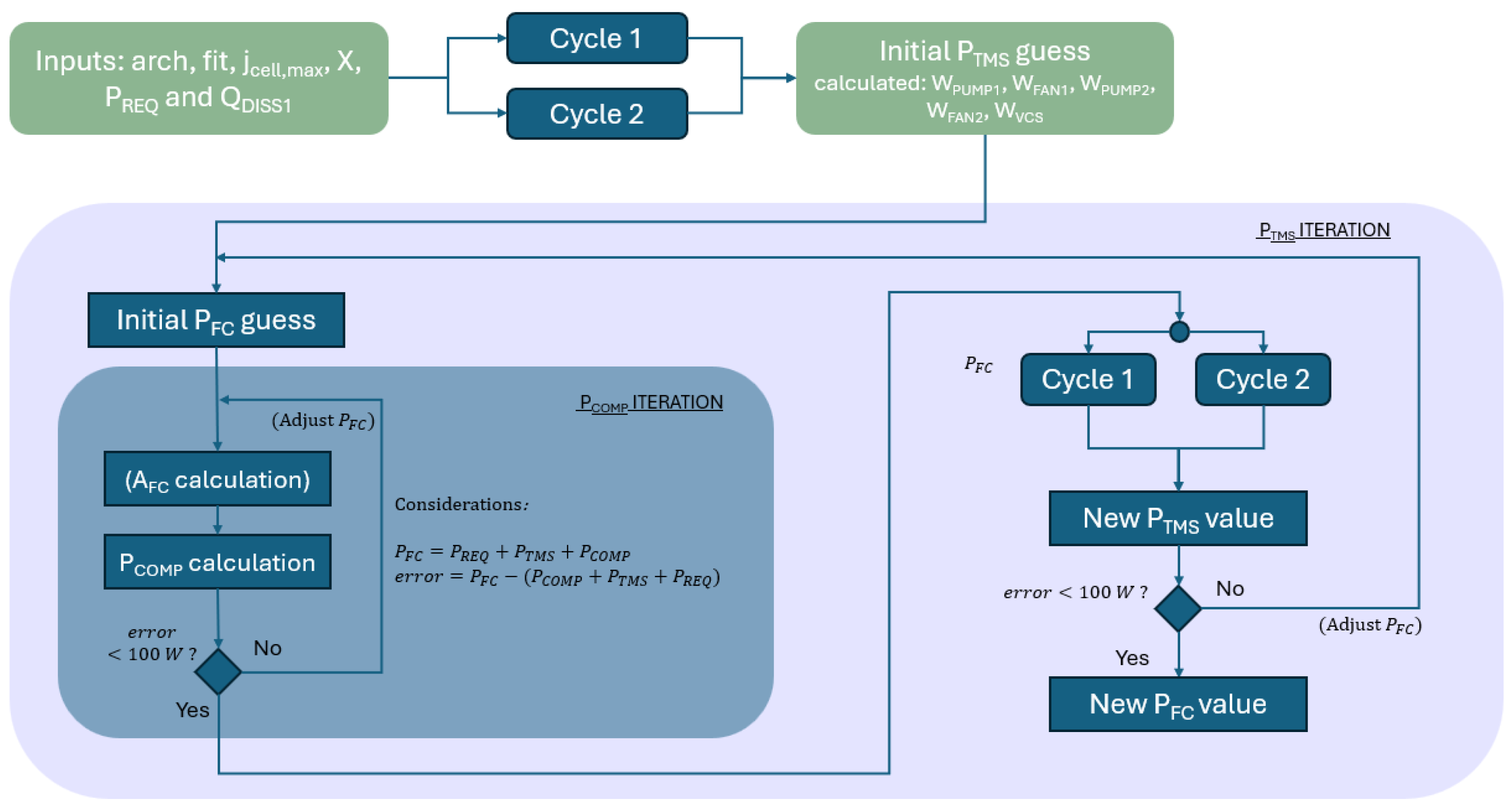


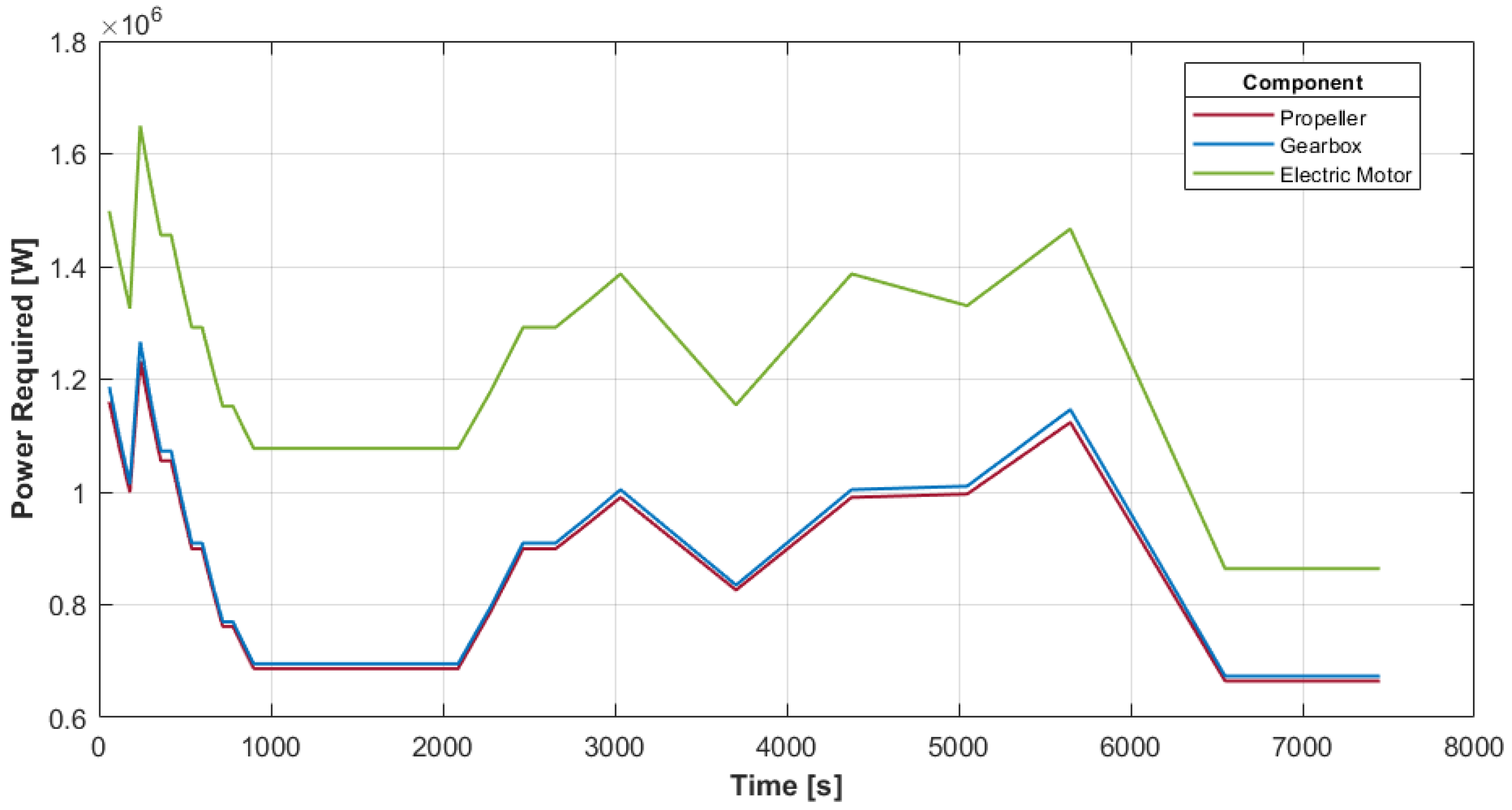

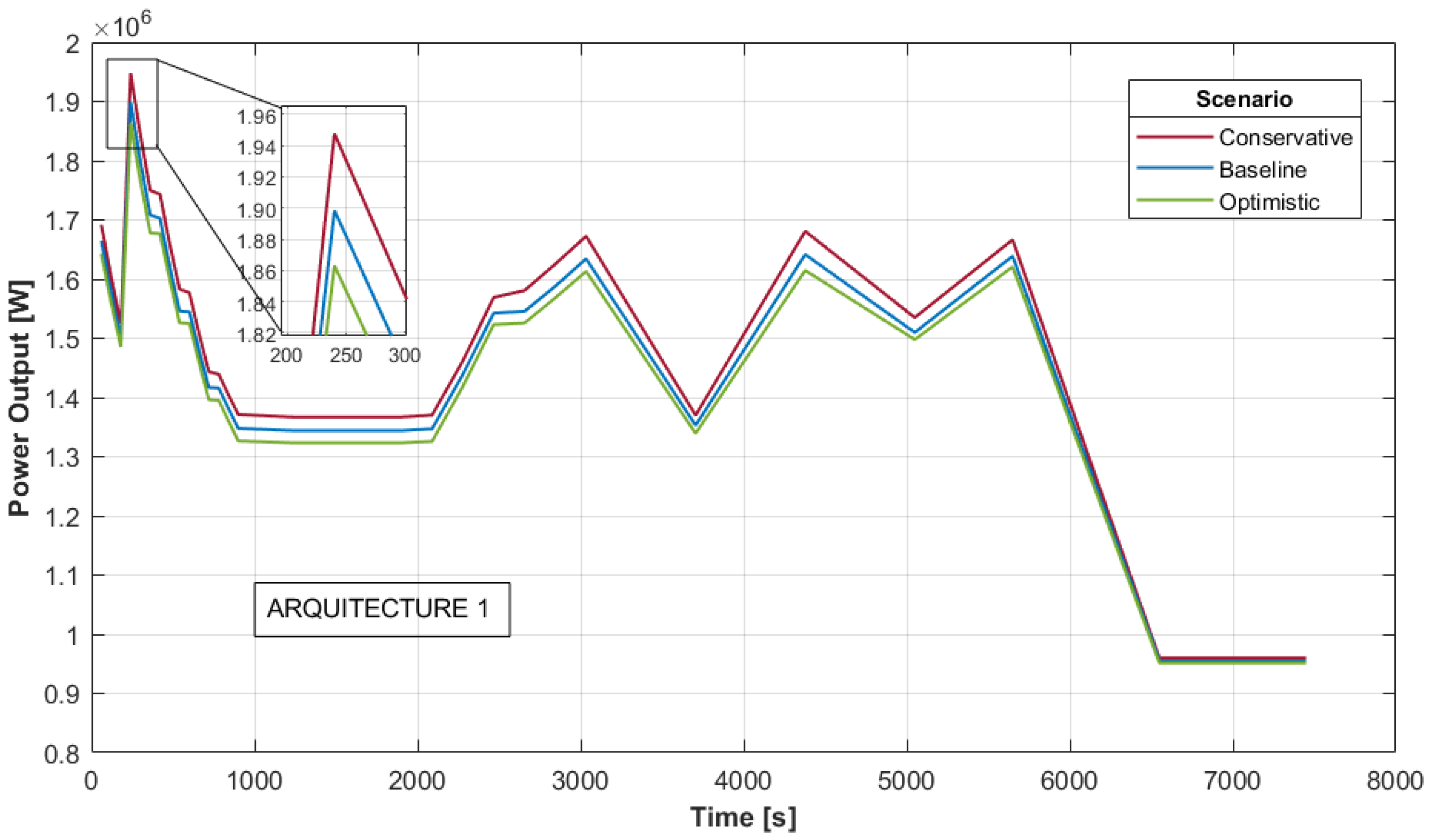
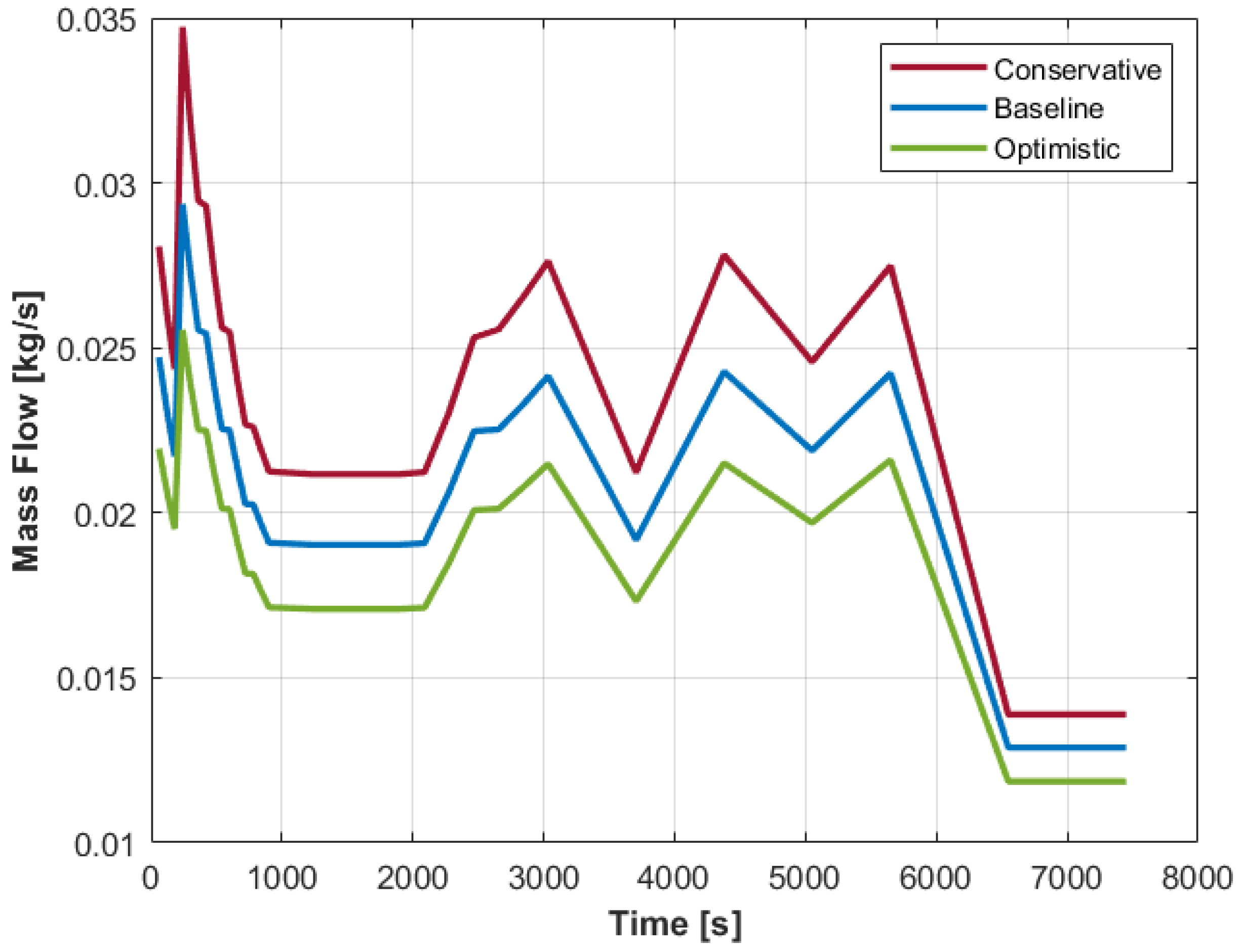

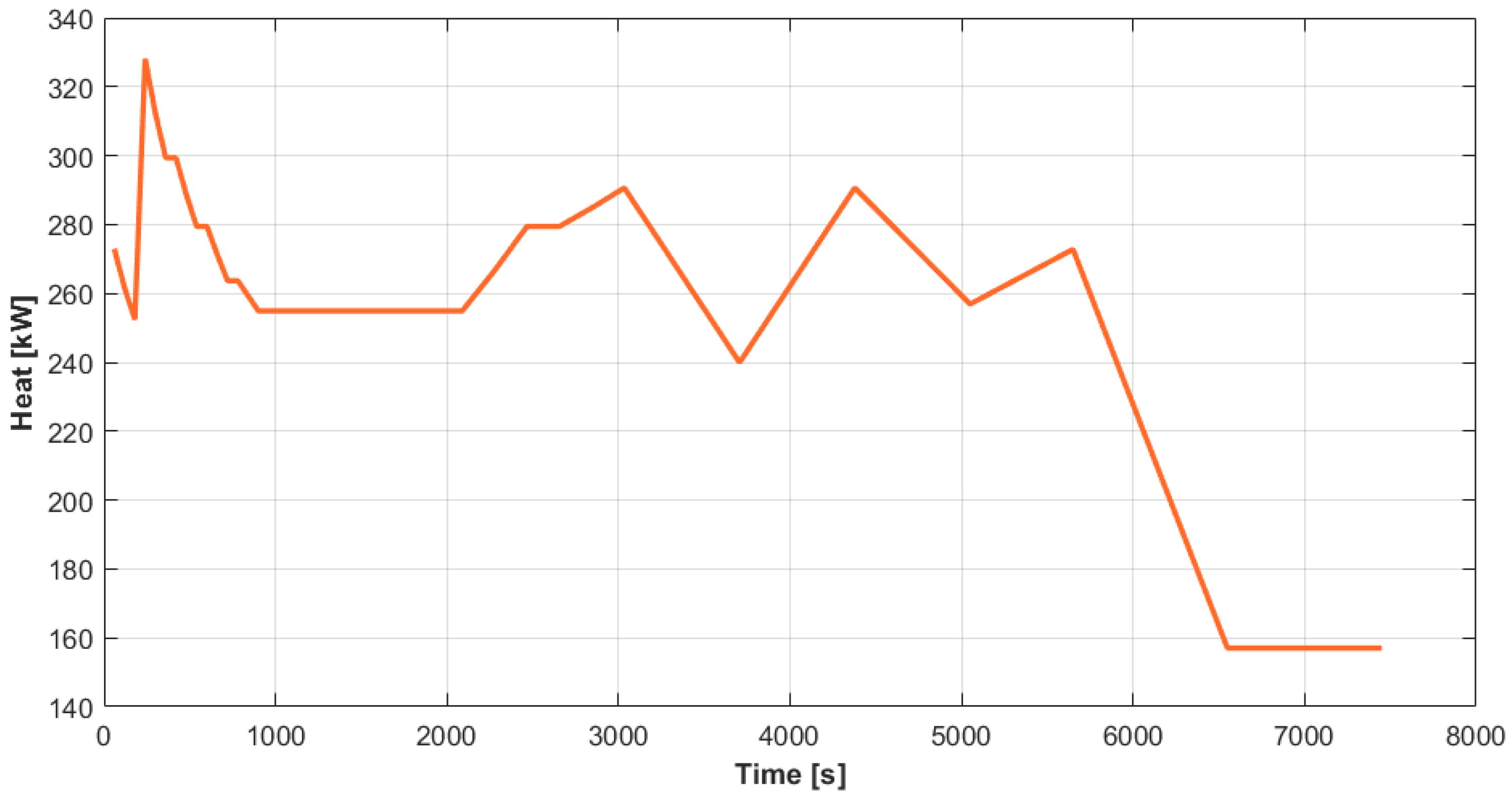


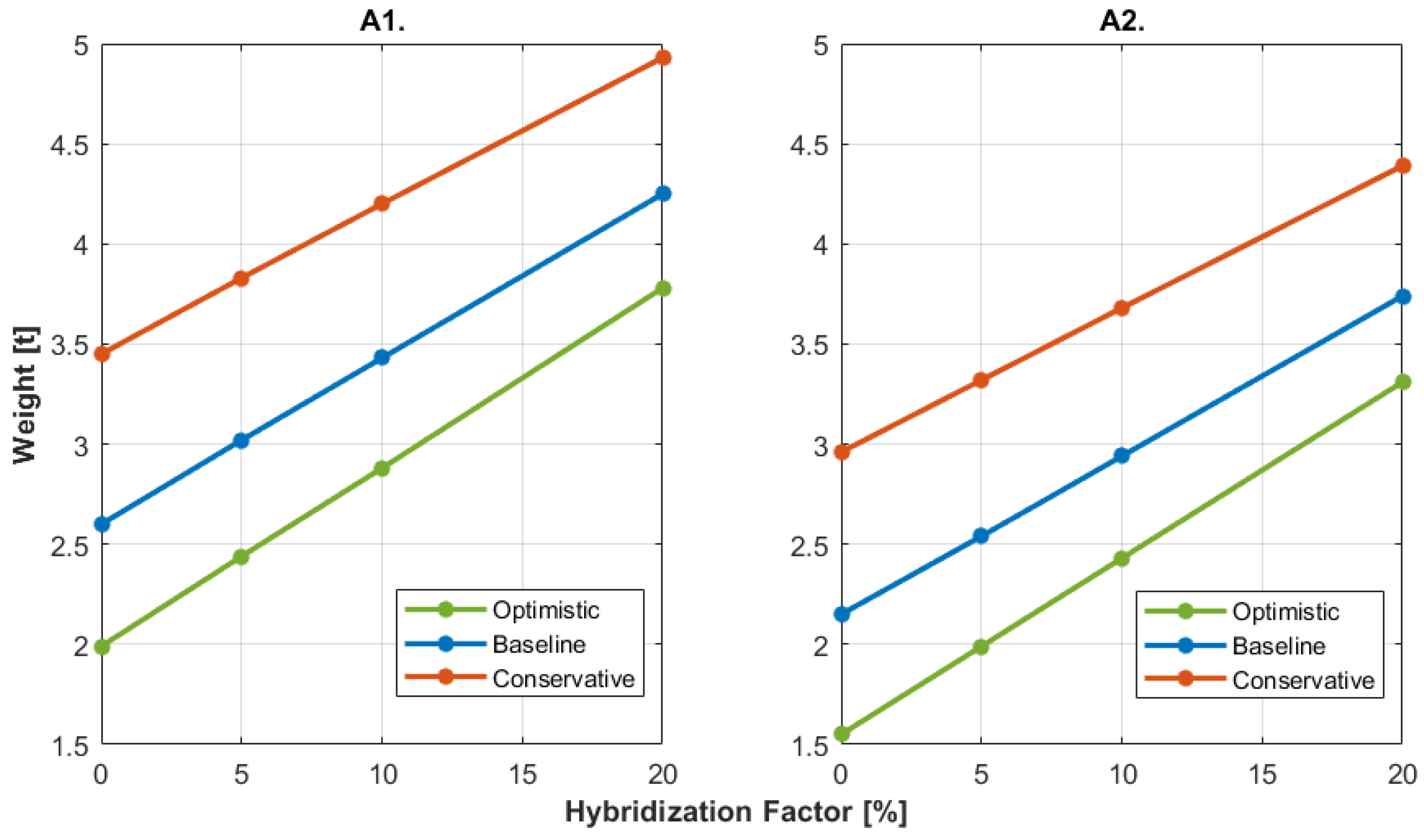
| Power | Value [ W] | Distribution [%] | Relative Difference [%] |
|---|---|---|---|
| 3.9334 | 100.0 | - | |
| 3.7461 | 95.2 | 0.0 | |
| 0.0975 | 2.5 | 0.0 | |
| 1.8527 | 47.1 | 1.1 | |
| 1.7959 | 45.7 | 0.0 |
| Contribution | Ticket | Value | Units | Reference |
|---|---|---|---|---|
| Gray Hydrogen | 12 | kg CO2-eq/kg | [53] | |
| Blue Hydrogen | 4 | kg CO2-eq/kg | [53] | |
| Li-ion battery | 40 | kg CO2-eq/(kWh) | [54] | |
| Electric Mix 1 | 258 | g CO2-eq/(kWh) | [55] | |
| Electric Mix 2 | 8 | g CO2-eq/(kWh) | [55] | |
| EGW (coal) | 7538 | kg CO2-eq/ton-EG | [56] | |
| EGW (biomass) | 3489 | kg CO2-eq/ton-EG | [56] | |
| R134a | 15.9 | kg CO2-eq/kg R134a | [57] |
| Component | Weight [kg] |
|---|---|
| Propeller | 165.00 |
| Gearbox | 14.37 |
| Electric motors | 158.26 |
| Total | 337.63 |
| Scenario | Area [m2] | [%] | Mass [kg] | [%] | ||
|---|---|---|---|---|---|---|
| A1 | A2 | A1 | A2 | |||
| Optimistic | 290.43 | 278.00 | −4.28 | 451.61 | 431.08 | −4.55 |
| Baseline | 332.91 | 318.91 | −4.21 | 899.22 | 859.57 | −4.41 |
| Conservative | 392.13 | 376.09 | −4.10 | 1516.20 | 1451.10 | −4.29 |
| Scenario | Hydrogen [kg] | Tank [kg] | Total [kg] | [%] | |||
|---|---|---|---|---|---|---|---|
| A1 | A2 | A1 | A2 | A1 | A2 | ||
| Optimistic | 140.54 | 133.78 | 60.23 | 57.33 | 200.77 | 191.11 | −4.81 |
| Baseline | 156.72 | 149.02 | 67.16 | 63.86 | 223.88 | 212.88 | −4.91 |
| Conservative | 175.95 | 167.01 | 75.41 | 71.58 | 251.36 | 238.59 | −5.08 |
| Scenario | Mass [kg] | [%] | Energy [MJ] | [%] | ||
|---|---|---|---|---|---|---|
| A1 | A2 | A1 | A2 | |||
| Optimistic | 557.75 | 173.71 | −68.86 | 445.77 | 6.29 | −98.59 |
| Baseline | 552.36 | 173.78 | −68.54 | 445.98 | 7.66 | −98.28 |
| Conservative | 544.77 | 173.87 | −68.08 | 445.96 | 9.24 | −97.93 |
| Scenario | Mass [kg] | [%] | Energy [MJ] | [%] | ||
|---|---|---|---|---|---|---|
| A1 | A2 | A1 | A2 | |||
| Optimistic | 419.66 | 399.04 | −4.91 | 6.97 | 6.47 | −7.17 |
| Baseline | 566.13 | 538.60 | −4.86 | 24.04 | 17.81 | −25.82 |
| Conservative | 773.76 | 737.81 | −4.65 | 78.94 | 63.72 | −19.28 |
| Scenario | X = 0 | [%] | X = 0.05 | [%] | X = 0.10 | [%] | X = 0.20 | [%] | |||||
|---|---|---|---|---|---|---|---|---|---|---|---|---|---|
| A1 | A2 | A1 | A2 | A1 | A2 | A1 | A2 | ||||||
| Pessimistic | 3 | 2.67 | 2.38 | −10.86 | 33.89 | 33.60 | −0.86 | 65.12 | 64.82 | −0.46 | 127.56 | 127.27 | −0.23 |
| 2 | 3.07 | 2.76 | −10.10 | 34.27 | 33.96 | −0.90 | 65.48 | 65.16 | −0.49 | 127.89 | 127.57 | −0.25 | |
| 1 | 3.59 | 3.25 | −9.47 | 34.77 | 34.43 | −0.98 | 65.95 | 65.60 | −0.53 | 128.30 | 127.96 | −0.27 | |
| Optimistic | 3 | 1.11 | 0.89 | −19.82 | 2.04 | 1.82 | −10.78 | 2.98 | 2.76 | −7.38 | 4.84 | 4.62 | −4.55 |
| 2 | 1.27 | 1.05 | −17.32 | 2.20 | 1.97 | −10.45 | 3.12 | 2.89 | −7.37 | 4.97 | 4.74 | −4.63 | |
| 1 | 1.48 | 1.25 | −15.54 | 2.40 | 2.16 | −10.00 | 3.31 | 3.07 | −7.25 | 5.14 | 4.90 | −4.67 | |
| Scenario | ARCH | Optimistic | Baseline | Conservative | ||||||
|---|---|---|---|---|---|---|---|---|---|---|
| 5% | 10% | 20% | 5% | 10% | 20% | 5% | 10% | 20% | ||
| Pessimistic | A1 | 1169 | 2339 | 4678 | 1016 | 2033 | 4066 | 869 | 1737 | 3473 |
| A2 | 1312 | 2624 | 5247 | 1130 | 2260 | 4522 | 959 | 1918 | 3837 | |
| Optimistic | A1 | 83 | 168 | 336 | 73 | 146 | 291 | 62 | 124 | 247 |
| A2 | 104 | 210 | 419 | 88 | 175 | 351 | 72 | 146 | 292 | |
Disclaimer/Publisher’s Note: The statements, opinions and data contained in all publications are solely those of the individual author(s) and contributor(s) and not of MDPI and/or the editor(s). MDPI and/or the editor(s) disclaim responsibility for any injury to people or property resulting from any ideas, methods, instructions or products referred to in the content. |
© 2025 by the authors. Licensee MDPI, Basel, Switzerland. This article is an open access article distributed under the terms and conditions of the Creative Commons Attribution (CC BY) license (https://creativecommons.org/licenses/by/4.0/).
Share and Cite
Filipe, M.; Afonso, F.; Suleman, A. A Study on Thermal Management Systems for Fuel-Cell Powered Regional Aircraft. Energies 2025, 18, 3074. https://doi.org/10.3390/en18123074
Filipe M, Afonso F, Suleman A. A Study on Thermal Management Systems for Fuel-Cell Powered Regional Aircraft. Energies. 2025; 18(12):3074. https://doi.org/10.3390/en18123074
Chicago/Turabian StyleFilipe, Manuel, Frederico Afonso, and Afzal Suleman. 2025. "A Study on Thermal Management Systems for Fuel-Cell Powered Regional Aircraft" Energies 18, no. 12: 3074. https://doi.org/10.3390/en18123074
APA StyleFilipe, M., Afonso, F., & Suleman, A. (2025). A Study on Thermal Management Systems for Fuel-Cell Powered Regional Aircraft. Energies, 18(12), 3074. https://doi.org/10.3390/en18123074







